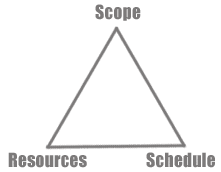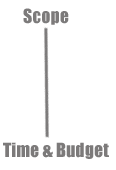The Broken Iron Triangle Is Broken
Filed Under Human Factors, Software Process

The Broken Iron Triangle is one of the timeless essays by Scott Ambler, but for most practitioners it is broken with the old equation: time = money.
In his article, Scott did give note to the fact that this model will fail when placed under unmanaged extremes; however, because most people refuse to recognize that in many business scenarios time equals money leaning heavily on this model fails us.
If the client is allowed to control 2 of the 3 corners, let’s start at the extremes to prove the point:
- Unlimited budget and manpower, but all features must be delivered by end of day
- All features must be delivered for $1, but I don’t care when
Again, Fowler did say that unrealistic and unmanaged scenarios would fail – 9 women can not produce a baby in 1 month – yet I still see people today trying.
Previously I was a consultant, paid by the client on an hourly basis. As a result, the client always requested that they control budget and scope. Why was this? Easy, they had (probably an unrealistic or underestimated) budget and they knew what they wanted. Since they were working with a consultancy that they were getting a 1:1 ratio on time to budget, they technically controlled all 3 corners!

Never have I had a client be foolish enough (from a business perspective) to relinquish control of scope as they all recognized that they could control the entire triangle. So if time = money, then the iron triangle become the “Broken Iron Line“. The client gets to manage one side and the development team the other side.
If the client is managing both time and budget but scope is flexible, doesn’t this sound a lot like Agile or SCRUM? If the client wants to control scope, then they must concede to the timeline and budget realities of accomplishing it. Ahhh…the Iron Line is so much easier.
If you have a good working relationship with your client, you can instead, use the Iron Line as a scale which to balance the two end points. Do they want 80% control of the budget, thus giving up 80% control of the scope? Do they want more scope control then budget control? In short, are they willing to go over X% of budget for X% of scope control?

Unmanaged, the Iron Triangle can cause a false sense of project security. The Iron Line presents less options which forces a mutual understanding between client and development. On your next project, try it out I think you find it more responsive than the Iron Triangle.
The bottom line is that something has to give, whether you want it to or not. – Scott Ambler
4 Responses to “The Broken Iron Triangle Is Broken”



I usually use the “Contractor’s Triangle:” — “Good, Fast, Cheap, pick any two” to get an idea of what my client wanted before we started a project. But I *insisted* on having a good control of scope by implementing a ticket system and setting up a “Current”, “Next”, “Future” version system. We’d go through a list of tickets together in Excel and I’d put my choices and they could confirm them.
[…] mariooster wrote an interesting post today onHere’s a quick excerptIf you have a good working relationship with your client, you can instead, use the Iron Line as a scale which to balance the two end points. Do they want 80% control of the budget, thus giving up 80% control of the scope? … […]
@Karl
The only thing I don’t like about the Contractors Triangle is it places quality at one of the corners. In my mind, lack of unit tests and quality is never an option – it cuts too deeply into my professional pride.
Would you want your name attached to crummy software even if it was the best business decision for your client? Personal preference I guess…
[…] few years. There’s Jurgen Appelo’s Iron Square, Jim Highsmith’s Agile Triangle, Max Pool’s Iron Line, and any number of other variations. At first glance, these seem like good thought models which […]